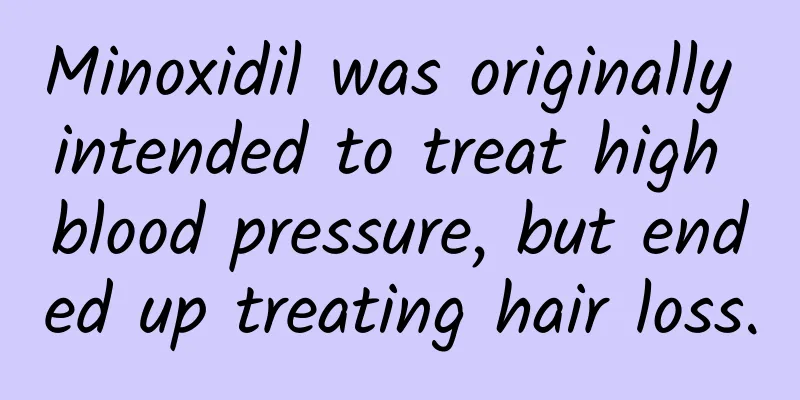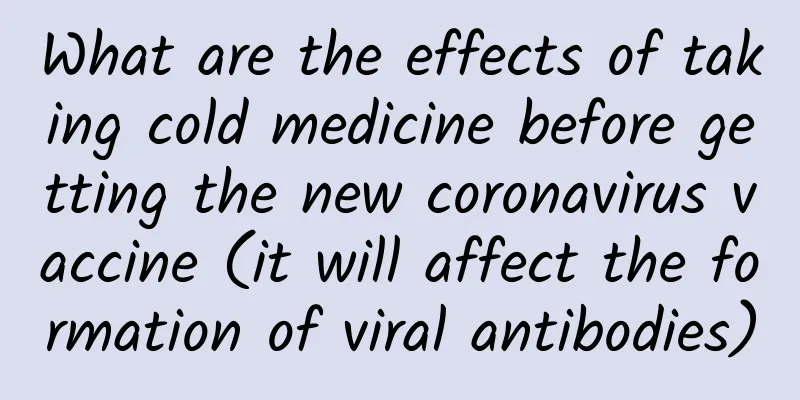Minoxidil was originally intended to treat high blood pressure, but ended up treating hair loss.

|
Initially, minoxidil was developed as a drug for the treatment of hypertension. Minoxidil is a potassium channel opener that increases the permeability of vascular smooth muscle cell membranes to potassium ions, allowing positively charged potassium ions in the cells to flow out, inhibiting the cells, relaxing vascular smooth muscles, dilating blood vessels, and lowering blood pressure. For example, the "electricity" carried by potassium ions can activate the "circuit switch" inside the vascular smooth muscle cells. But minoxidil steals the "electricity", so the "circuit switch" of the vascular smooth muscle cells cannot be activated, causing the vascular smooth muscle cells to be inhibited and dilated. Therefore, minoxidil is a vasodilator that can produce a powerful dilation effect on small arteries, reduce peripheral resistance, and lower blood pressure. 1. The efficacy of the drug "goes astray" due to side effects. Side effects may occur during the use of minoxidil to treat hypertension, including tachycardia, skin flushing, water and sodium retention, lower limb edema, and a few people may experience allergies and itching. During the period of medication, if the daily dose exceeds 10 mg, hirsutism may occur, and the hirsutism symptoms will subside within a few months after stopping the medication. People require drugs for treating hypertension to be stable and long-lasting, but minoxidil cannot meet these requirements and can only be used as a second- or third-line drug for treating hypertension. However, the side effect of minoxidil, which can cause hirsutism, has caught people's attention, so people have turned to studying the therapeutic effect of minoxidil on hair loss. However, to this day, the mechanism of action of minoxidil on hair follicles is still unclear, but there are many hypotheses. It may be that it can directly stimulate the proliferation and differentiation of hair follicle epithelial cells; open potassium channels, dilate blood vessels, increase blood flow and nutrient supply to hair follicles; transform hair follicles from the resting phase to the growth phase, and prolong the growth phase of hair follicles. In the study, it was found that minoxidil is also effective when applied topically to the hair growth area, and it can avoid systemic adverse reactions. Therefore, minoxidil is now more commonly seen in the form of sprays, gels, tinctures, liniments and other topical treatments for hair loss, while oral dosage forms for the treatment of hypertension are almost non-existent. In other words, minoxidil, which was originally used orally to treat hypertension, has "deviated" to the role of topical treatment for hair loss because of the side effect of hirsutism. 2. The "side effects" of drugs can also cure diseases. Many people confuse the "side effects" of drugs with "adverse reactions", but in fact they are different concepts. Side effects refer to the pharmacological effects of drugs that are unrelated to the purpose of treatment during normal treatment. Adverse reactions refer to the harmful reactions that are unrelated to the purpose of treatment but occur during normal treatment. In other words, side effects are harmless but useless to the human body, while adverse reactions are harmful to the human body. In fact, many drugs are discovered to have side effects with greater therapeutic value during use, thus deviating from their original development purpose. For example, the familiar aspirin was originally developed as an antipyretic and analgesic. However, during the use of the drug, people found that it had the side effect of inhibiting platelet aggregation, so now aspirin has become a "magic drug" for preventing thrombosis and treating cardiovascular and cerebrovascular diseases. There is also sildenafil, which was originally developed to dilate blood vessels and treat heart disease. However, during the use of the drug, it was found that it can treat male erectile dysfunction (ED), so the purpose of its use was changed and it became the world-famous "Viagra". In fact, the same is true for minoxidil. It cannot compete with first-line antihypertensive drugs such as dihydrotestosterone, pril, sartan, lol and diuretics in the treatment of hypertension. However, it has taken a different approach and used its side effects to gain a place in the field of hair loss treatment. 3. Common problems with minoxidil in treating hair loss 1. Different concentrations for male and female hair loss: Minoxidil topical preparations are commonly available in 2% and 5% specifications. 2% can be used for female hair loss, while 5% can only be used for male hair loss. The different concentrations for male and female use are due to the regulations of the US Food and Drug Administration (FDA). In 1991, the US FDA approved 2% minoxidil for female hair loss, and in 1997 approved 5% minoxidil for male hair loss, but not for female hair loss. Each effect of a drug approved by the FDA requires a large number of experiments to prove it. This shows that 2% minoxidil has been tested and is effective and safe for female hair loss, but the safety of 5% minoxidil for women is unknown. Therefore, the safest and most reasonable way to treat female hair loss is to use 2% minoxidil. 2. Dosage and usage of minoxidil: When using 2% minoxidil, use 1 ml twice a day; when using 5% minoxidil, use 1 ml once or twice a day. Apply to the affected area, starting from the center, and massage with your hands for 3 to 5 minutes. Increasing the daily dosage will not increase the efficacy. The important thing is to use it every day. Before using it, you need to make sure it is used on a normal scalp. If the hair loss is caused by trauma or scars, minoxidil will not work. When minoxidil is used to treat hair loss, it is necessary to have normal hair follicle mother cells on the scalp. If the hair follicle mother cells are already necrotic, it will not be effective. So after using the medicine, it takes 6 months to observe. If it works, you can continue to use it. If it doesn't work, then continuing to use it will not work. Be careful not to apply this product to other parts of the body when using it. Wash your hands immediately after use. This product is irritating. If it accidentally splashes into the eyes, mucous membranes, or wounds on the skin, rinse immediately with plenty of water. 3. Adverse reactions to minoxidil: When minoxidil is used externally, irritant dermatitis may occur, with symptoms such as redness, swelling, dandruff, and burning pain. Local adverse reactions such as erythema, itching, nonspecific allergic reactions, wheals, and allergies may also occur. Minoxidil for external use will be absorbed through the skin in small amounts. People with sensitive constitutions may experience adverse reactions such as allergic rhinitis, shortness of breath, headache, dizziness, changes in blood pressure, palpitations, etc. If you are a patient with coronary heart disease, it may also induce angina pectoris. Pregnant and breastfeeding women should not use it because this product will be absorbed through the skin and may affect the fetus or infant. 4. A "crazy shedding period" may occur when taking the drug: Before taking the drug, most of the hair follicles of many patients are already in the resting phase. At this time, the hair follicle mother cells shrink and are separated from the blood supply area, and the hair attached to them no longer grows. When stimulated by minoxidil, the hair follicle mother cells will reconnect to the blood supply and grow hair again. However, the new hair will not grow together with the old hair, but the old hair needs to be "pushed away" before the new hair can grow out. In other words, the regrowth of hair is "old hair does not go, new hair does not come". The "shedding period" will last about 15 days to 1 month, and you need to continue taking the medicine. Don't stop taking the medicine because of fear of "shedding". It takes some time for the new hair to grow out of the epidermis, and it will take about 3 months to see the hair growth effect brought by the medicine. 5. Is minoxidil addictive? The cause of hair loss is related to the individual's physique. For example, male androgenic alopecia is related to genetic inheritance. The hair follicle stem cells of men with hair loss are more sensitive to male hormones and will enter the resting phase earlier. The effect of minoxidil is only to stimulate blood vessels and hair follicle cells to return to the growth phase, which can improve symptoms, but it cannot change genes. If you stop using minoxidil, the original cause of hair loss will regain the upper hand and continue to cause hair loss. So essentially, it is not that minoxidil will cause dependence, but the cause of hair loss cannot be cured and can only be controlled through continued medication. It should be noted that when using minoxidil for a long time, if you suddenly stop taking it, the hair follicle stem cells will suddenly lose the drug stimulation, which may cause stress shedding and cause large-scale hair loss. To avoid this, you should gradually reduce the dosage when you stop taking it, such as reducing the dosage from twice a day to once a day; after a two-week interval, reduce it to once every three days; after another two-week interval, reduce it to once a week, and then stop taking it. 6. Minoxidil can improve hair quality: Some people who do not have hair loss want to improve their hair quality by applying minoxidil because they have less hair or their hair is fine and soft. From the perspective of drug action, minoxidil can dilate and proliferate capillaries, allowing hair follicle cells to obtain more nutrition, which may make hair thicker. Although it may be effective, it is not recommended to use minoxidil to improve hair quality. Because minoxidil only changes the appearance, it cannot change the root cause of poor hair quality. After stopping the drug, the hair quality will still return to the state before the drug. In addition, during the medication period, adverse drug reactions may occur. When stopping the drug, there is also a risk of stress-induced hair loss. In summary, minoxidil is a drug that has gone from treating high blood pressure to treating hair loss. It needs to be used externally to treat hair loss. Note that the concentrations used by men and women are different, and pay attention to the occurrence of side effects. Safe use of the drug requires guidance from a doctor. If you have any questions about the use of the drug, please consult a doctor or pharmacist. I am pharmacist Huazi, welcome to follow me and share more health knowledge. |
Recommend
What should women pay attention to in health exercises
Physical exercise can greatly improve our body, b...
What is the condition of heavy breathing after pregnancy
Many women will find that their breathing becomes...
What should a woman do if she wakes up with body aches?
Many people have experienced this phenomenon in t...
What happens if there are lumps around the breast?
Breasts are one of the most beautiful parts of he...
Diabetics should be careful about eating and drinking too much during the Chinese New Year!
How did you spend this year's Spring Festival...
What will happen if I have two miscarriages in half a year?
Nowadays, many girls do not pay attention to thei...
How to massage breast pain?
Breasts are a symbol of female beauty. Full breas...
Why do women get kidney stones?
Generally speaking, when we talk about some probl...
Can I eat glutinous rice balls during confinement after a normal birth?
In addition to being eaten on some traditional fe...
How can girls get a six-pack?
Fitness is now a very common recreational sport. ...
Is it good to have sex during menstruation?
It is very normal for couples to have daily sex, ...
First time menstruation with blood clots
Girls usually don’t know much about menstruation ...
What are the factors that affect menstruation?
Many female friends often complain that their men...









